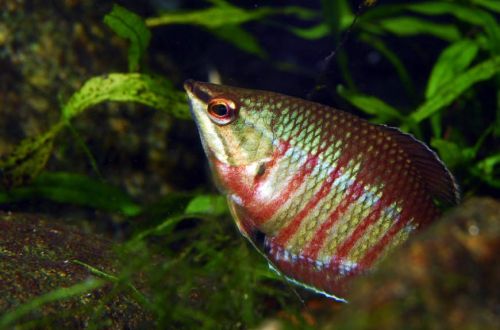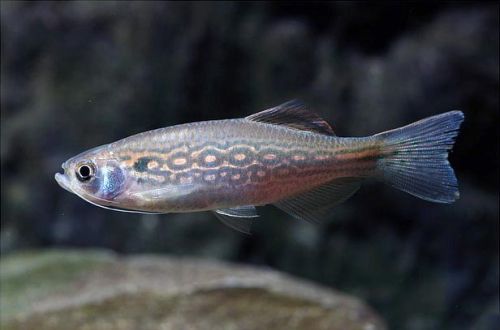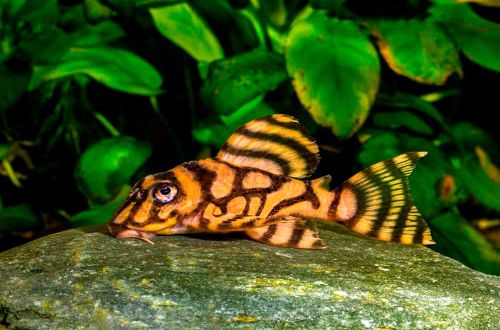
Veilant’s gourami
Veilant’s gourami, scientific name Sphaerichthys vaillanti, belongs to the Osphronemidae family. A relatively easy fish to keep and breed, compatible with many other species. It is believed that the main population of this species is now kept in aquariums rather than in the wild, where the fish are on the verge of extinction.

Contents
Habitat
It comes from Southeast Asia from the Indonesian part of the island of Borneo. Inhabits the upper basin of the Kapuas River in the province of West Kalimantan. Typical habitats are peat bogs and streams and rivers flowing in / out of them, located among dense rainforest. The water in the swamps is colored in a rich brown color due to the high concentration of dissolved tannins and humic acids released as a result of the decomposition of plant organic matter. The bottom is covered with a thick layer of fallen leaves, twigs and various snags. Aquatic vegetation is represented by shade-loving plants and numerous aquatic mosses and ferns.
At present, the natural habitat has been severely degraded due to active human activities: pollution, illegal gold mining, deforestation, massive tropical fish harvesting for the expert, and much more. It is believed that in nature this species is almost never found.
Brief information:
- The volume of the aquarium – from 60 liters.
- Temperature – 21-25°C
- Value pH — 3.5–6.5
- Water hardness – 1–3 dGH
- Substrate type – any dark
- Lighting – subdued
- Brackish water – no
- Water movement – little or no
- The size of the fish is about 5 cm.
- Food – any food
- Temperament – peaceful
- Content – in a group of relatives and together with other species
Description
Adults reach a length of about 5 cm. The fish have a high flattened body and a pointed head. The dorsal and anal fins extend from the middle of the body to the tail. When in a favorable environment, sexual dimorphism is clearly expressed. The profile of the head of the female is even, the coloration consists of a combination of green and red colors, which intensifies during spawning. In males, the lower jaw is somewhat retracted, forming a pouch; males are gray or brownish.
Food
A carnivorous species, in nature it feeds on small aquatic crustaceans, worms, insect larvae and other zooplankton. Acclimatized fish begin to accept alternative foods. For example, a daily diet may consist of a combination of dry flakes and pellets combined with live or frozen foods: bloodworms, brine shrimp, mosquito larvae, fruit flies, daphnia, etc.
Maintenance and care, arrangement of the aquarium
The optimal size of the aquarium for a small group of fish starts from 60 liters. Veilant’s Gourami will look most harmoniously in low or diffused lighting among snags and thickets of aquatic plants against a dark substrate. It is recommended to form several shelters or add decorative elements that can be used in this capacity. They come in handy during breeding. If the design is not of great importance, then ordinary ceramic pots turned over on their side, pieces of hollow PVC tubes and so on will come in handy.
Adding the dried leaves of some trees will not only give the aquarium more naturalness, but also help to saturate the water with tannins, so that the composition of the water begins to resemble the composition of water in natural reservoirs.
Successful maintenance depends on the quality of the water and the hydrochemical composition of the water. Unlike relatives living in flowing waters, this species is not so demanding on the purity of water and can withstand certain concentrations of organic waste. Unless, of course, they provoke a violation of the normal course of the nitrogen cycle. As for pH and dGH, they should be in the range of acidic and mild values, corresponding to the water in the swamps. The stability of the biological system will be determined by the regularity of maintenance procedures (replacement of part of the water with fresh water, removal of waste) and the smooth operation of the equipment. First of all, the latter refers to the filtration system. In some cases, a simple airlift filter with a sponge can be an excellent choice.
Behavior and Compatibility
Peaceful calm fish. Although it does not belong to the schooling species, being in the company of relatives is considered preferable. It is recommended to purchase a group of 6 individuals. The choice of neighbors should be approached with caution. Too active and large fish will easily intimidate the harmless Veilant Gourami and push him to the periphery.
Breeding / breeding
Breeding is quite simple. This species bears eggs in the mouth, and males do this, which is why they have a pouch on the lower jaw. Courtship is initiated by the female, or the alpha female if a group of fish is kept.
The spawning process takes several hours and takes place near any shelter, inside which 10–40 eggs are laid. After fertilization, the male takes them into his mouth and retires to a quiet place away from the rest of the fish. The incubation period lasts 7–20 days, after which fully formed fry appear. From this point on, parental instincts weaken, but juveniles can still be near their parents without fear of being eaten. However, this cannot be expected from other fish, so it is safer to keep fry in a separate tank.
Fish diseases
The cause of most diseases is unsuitable conditions of detention. A stable habitat will be the key to successful keeping. In the event of symptoms of the disease, first of all, the quality of the water should be checked and, if deviations are found, measures should be taken to correct the situation. If symptoms persist or even worsen, medical treatment will be required. Read more about symptoms and treatments in the Aquarium Fish Diseases section.





